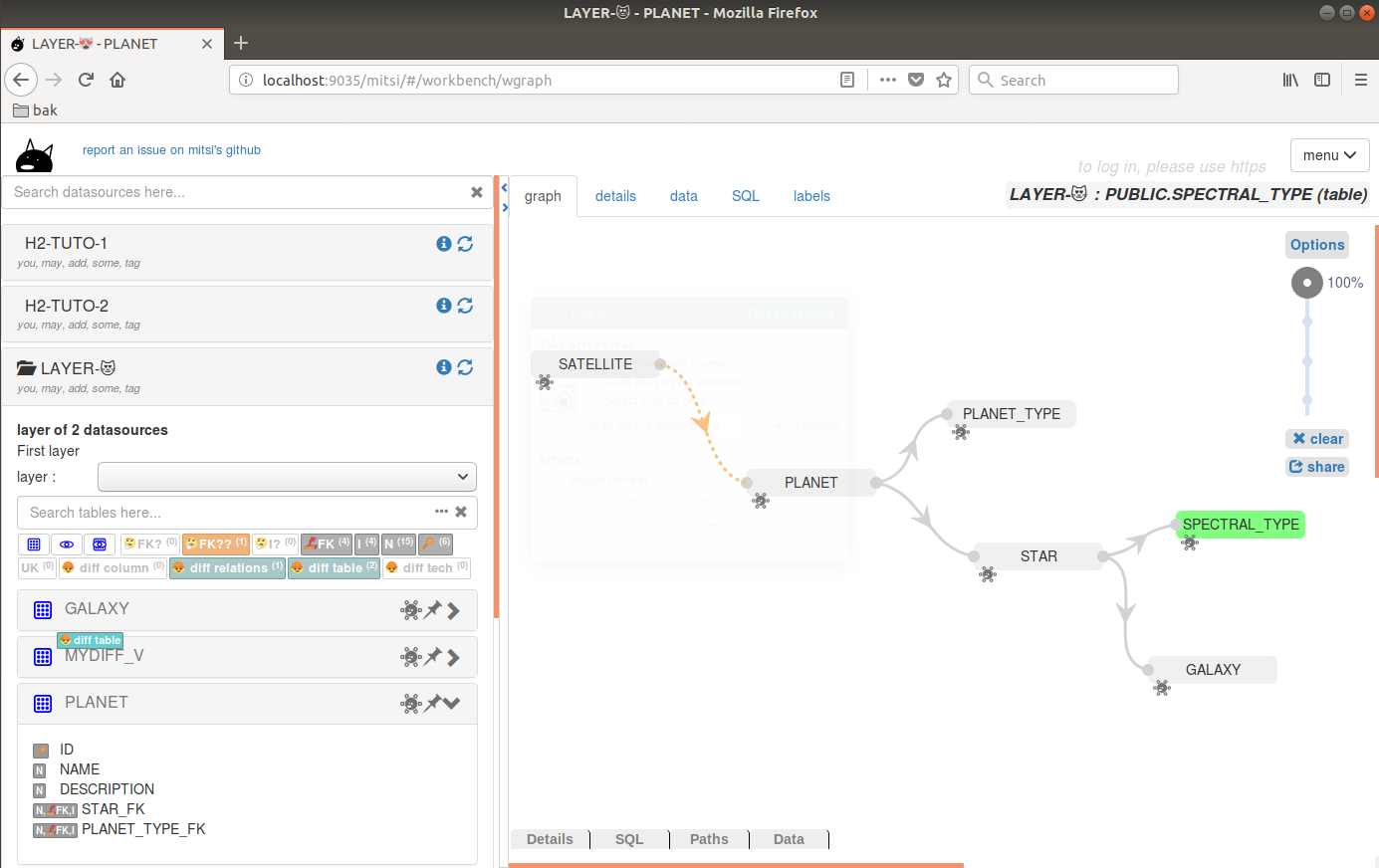Mitsi is a very simple web application to explore a relational database. It works for Oracle, PostgreSQL, H2 and MySQL/MariaDB, and can be extended to other RDBMS.
With it you may explore your physical data model easily. You can also define labels to find anomalies in your datamodel, and use layers to see differences between databases instantly.
- Instant search bar for tables, columns, indexes and constraints
- Graph navigation, and graph interactions to display table data and metadata
- Pathfinding using the relation graph
- "Candidate FK" detection to find FK to create, or to display links between tables that are not defined as foreign key constraint
- Layers to display differences between database schemas
Watch this silent video to see this functionalities in action : https://www.youtube.com/watch?v=VqIGvtIy5l0
Java (version >= 7) must be installed, and the JAVA_HOME environment variable must be set.
If you download it there, you will have a tomcat pre-configured with the Mitsi war. Unzip the archive (.zip or .tar.gz). Then modify the following files to configure your first database connection :
In this file you can configure the list of datasource that you will manage with mitsi. As an example, two basic datasouces are given but you can configure as many as you want.
- provider : h2, oracle, postgre or mysql (other providers can be defined in plugins)
- driver : the class name of the JDBC driver you want to use. You may add other drivers using plugins, but the following drivers are provided in mitsi
- For oracle : oracle.jdbc.driver.OracleDriver
- For PostgreSQL : org.postgresql.Driver
- For h2 : org.h2.Driver
- For MySQL/MariaDb : org.mariadb.jdbc.Driver The connection attributes are straightforward :
- jdbcUrl is the jdbc url to connect to the database.
- For Oracle databases, you may use the models jdbc:oracle:thin:@hostname:port:SID or jdbc:oracle:thin:@//hostname:port/service
- For PostgreSQL, you may use the model : jdbc:postgresql://hostname:port/database
- For H2 : jdbc:h2:file:/path/to/your/db
- For MySQL/MariaDB
- user : username to connect to the database
- password : password to connect to the database
Others datasource attributes will be used by mitsi :
-
description will be displayed along with the datasource
-
tags will be used to search or filter datasources
-
maxExportRows max number of rows displayed or exported
-
maxRunningStatementPerUser : max number of statement that a single user my run at the same time on the same datasource
-
userGroups is used to specify which users will have the rights to see and access the datasource. Two specials groups mays be used here :
- _public : the datasource can be accessed by anybody, even if no login has been provided
- _connected : any connected user will be able to access the datasource
-
pool : connection pool parameters. for example : "pool" : { maxIdleTimeSec : 600, maxSize : 5}
- initialSize : pool size when connecting for the first time (default : 0)
- minSize : minimum pool size (default : 0)
- maxSize : maximum pool size (default : 5)
- maxIdleTimeSec : maximum time, in seconds, a connecting will be kept while being idle
- acquireIncrement : number of connections acquired at once
This file is used to configure user management. There is three section in it :
- users is a list of users and there passwords (optional). This section is a convenient to configure the users, but is is advised to use ldap configuration instead.
- ldapAuthent is used to configure the ldap server if you have one(optional).
- groups defines a list of groups. Each group may contain many users or groups. These groups can be used in the datasource configuration, with the userGroups attribute, to restrict access to a datasource to some users.
Mitsi is packaged with default rules. You may keep this file as it is, but if you want to adapt it to your databases, you will find more details in the wiki : https://github.com/jelebg/mitsi/wiki/mitsi-rules-configuration-guide
By default, mitsi is accessible on the port 9035.
If you installed it on a server, you may access it using this URL : http://<your_server_hostname>:9035/mitsi/
If you installed it on your desktop, you may also use this URL : http://localhost:9035/mitsi/
to compile sources, you will have to download oracle's jdbc driver, compile the custom version of c3p0 and compile mitsi :
-
download ojdbc7.jar on oracle's website
-
mvn install:install-file -Dfile=ojdbc7.jar -DgroupId=oracle -DartifactId=oracle-jdbc-driver -Dversion=1.0.0-repo -Dpackaging=jar
-
git clone https://github.com/jelebg/c3p0_mitsi/tree/mitsi-c3p0-0.9.5.2
-
switch to mitsi's specific branch : git checkout mitsi-c3p0-0.9.5.2
-
create the lib library and place mchange-commons-java-0.2.11.jar and mchange-commons-java-0.2.11-sources.jar in it (you can download here for example : http://repo1.maven.org/maven2/com/mchange/mchange-commons-java/0.2.11/)
-
compile it with ant
-
install the jar in the maven repo : mvn install:install-file -Dfile=build/c3p0-0.9.5.2.jar -DgroupId=com.mchange -DartifactId=c3p0 -Dversion=0.9.5.2-mitsi -Dpackaging=jar
-
clone mitsi : git clone https://github.com/jelebg/mitsi.git
-
mvn clean install -DskipTests
